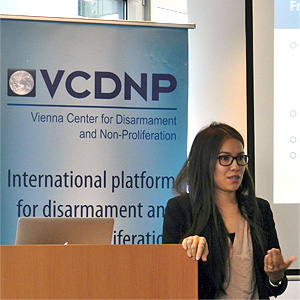

On 26 May 2015, VCDNP Research Associate Tamara Patton Schell presented on "New Technologies and Opportunities for Nuclear Disarmament and Non-Proliferation Verification” at a seminar for diplomats and missions held at VCDNP. Her presentation detailed ways that rapid increases in the volume and availability of digital information and satellite imagery, as well as technologies to analyze this information, are giving rise to new opportunities to meet the needs of arms control, non-proliferation, and disarmament verification.
Through illustrative case examples assembled by experts at VCDNP and the James Martin Center for Nonproliferation Studies (CNS) fusing a variety of information types, Ms. Patton Schell detailed the potential verification benefits and limitations of emerging tools in the burgeoning fields of “big data” and social media analysis, satellite imagery and geospatial analysis, and 3D visualization and virtual reality. She discussed these tools and information fusion concepts in the context of both existing and future treaties and regimes, including Fissile Material Cut-off Treaty (FMCT) and nuclear arms control and disarmament verification.
Ms. Patton Schell also discussed the launch of VCDNP's research collaboration with Copernicus, Skybox Imaging, and European Space Imaging (EUSI) under the Copernicus Masters Competition. With support from the United Kingdom, this project will examine the verification utility of emerging Earth observation capabilities such as frequent revisit rates afforded by agile constellations of small satellites, high-definition video, and emerging synthetic aperture radar systems.
Discussion following the talk engaged international perspectives on research needs pertaining to the use of emerging data and tools in verification contexts. The conversation included a useful examination of ways that research, industry, and government can collaborate to develop technical solutions that can support verification practitioners in assessing the validity of various emerging forms of publicly available information. Some possible solutions raised included improving methods for correlating disparate information sources, such as through data validation algorithms and fusion systems, and, in the case of satellite imagery use, by working to ensure access for all relevant parties to commercial imagery sources.
For related research and publications from VCDNP and CNS, view:
New Nonproliferation & Disarmament Verification Technology